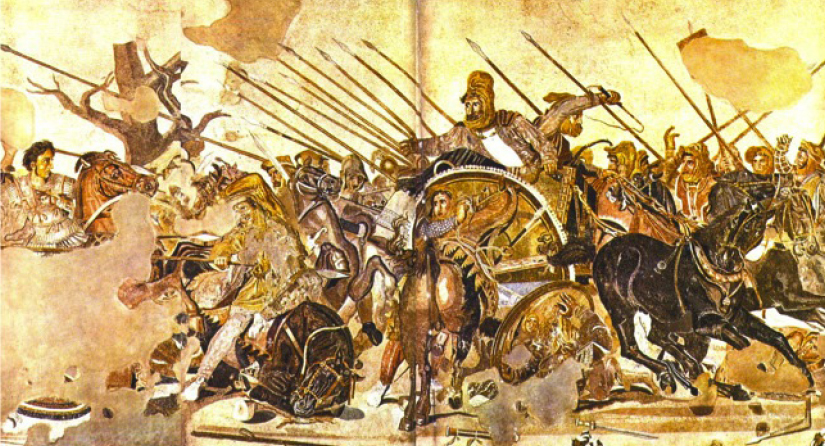4.7 DOCUMENT 4.6: The Alexander Mosaic, ca. 100 B.C.E.
DOCUMENT 4.6
The Alexander Mosaic, ca. 100 B.C.E.
The enduring interest in Alexander long after his death was reflected in Hellenistic and Roman art. Throughout both periods, artists produced paintings, sculptures, and coins depicting the conqueror. Perhaps the most famous, and certainly one of the most interesting, examples of Alexander-inspired art is the Alexander mosaic, a large floor mosaic discovered during the early-nineteenth-century archaeological excavation of the Roman city of Pompeii. Measuring nineteen feet by ten feet and composed of roughly 4 million individual tiles, the mosaic depicts a battle between Alexander the Great and Darius III of Persia. While there is some debate about which battle is shown in the mosaic, there is a clear consensus that the makers of the mosaic used a Hellenistic painting completed around 300 B.C.E. as their model. As you examine the image below, reflect on the artists' intentions. What did they want to communicate about the relationship between Alexander (at far left) and Darius (in the chariot)? Why might the Roman owner of the mosaic have commissioned such a work?

QUESTIONS TO CONSIDER
Question
jDaPPSVIUBo9a961x/5fw/twqNwxn/mGxekYErP84V88NpFGgUK/fvcpe5LxpDEF4g9zS9gkGqxhQNV3JObQ6nY5OKbmrpkyl4QDnEfs317YWWAzG4SdMN4CUM9uXA+EtjShIGMPegl4KVPizeYLre/8EMNf12fCCdQBVQ/Q8Iab9nkeaQAG8XA+2WiIRSCouDrSZyNN8scsGbdaUgvKovZP8jM2442ZQuestion
gFsjTCm+ZCPhV/lrBhpDUkmU5DETDF7p027/T2uMo+n5XlZQOCAx7/THTcAnO9Fv368IthXYK+XMsMPM4NTBzoO0X1SZ6lfATaAH7zflQbLYeF/E+MV6gio9pZ+qqYyH